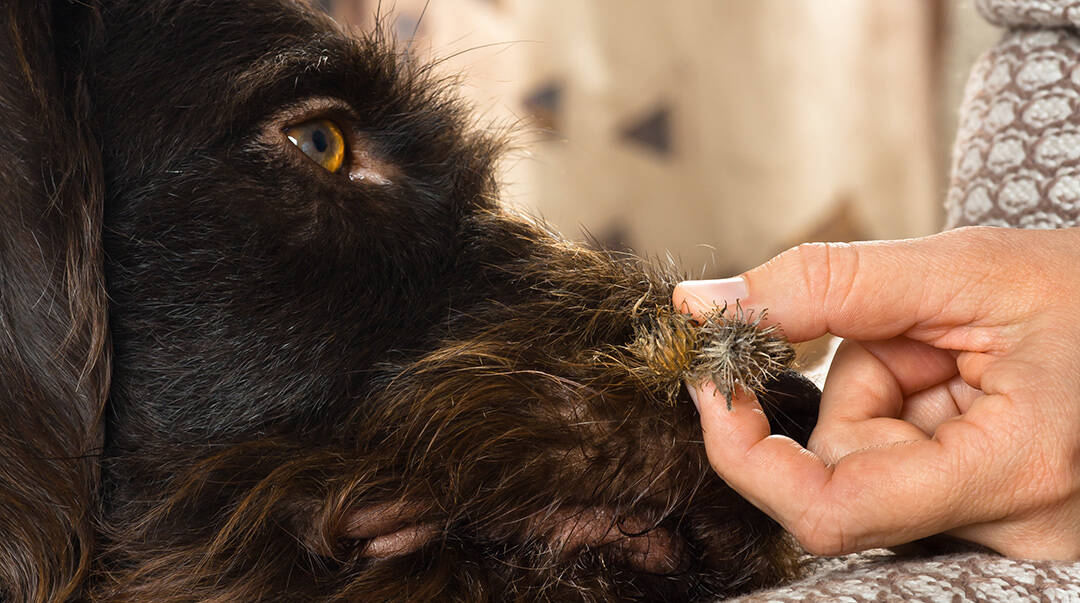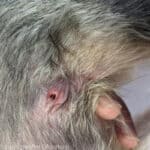A relaxing stroll with your Doodle dog through a meadow teeming with wildflowers can certainly be enjoyable, but when you return home to find both yourself and your dog covered with sticky burrs, your pleasant afternoon quickly turns into a nightmare.
Burrs are uncomfortable for your Doodle dog to say the least, and they often take lots of tedious, time-consuming work to remove.
It is, however, critical to remove each and every one from your dog’s coat to prevent mats, infection, and pain.
How do you find and remove burrs from Goldendoodles, Labradoodles, and other Doodle Dogs? Whether you call them burrs, stickers, sticky-balls, or stick-tights, they must be removed. Manually inspect the dog’s entire body and pick or comb out any burrs found. Embedded burrs may be crushed with pliers and lubricated with oil to ease removal.
Sticky burrs can be a huge pain for both you and your Doodle. Knowing what to look for, which areas to avoid, and how to safely remove embedded burrs can lessen the associated dread and let you enjoy outside time with your Doodle again.
As an owner of 2 Labradoodles myself, I know how tough it can be to find good information. In the 60+ pages of this book, I share the information, resources, and breed-specific tips I wish I’d had from the start. You will save you time, money, and loads of frustration…take my word for it!
How to Remove a Burr From a Doodle Dog’s Fur
When you find a burr, or multiple burrs, keep calm so as not to panic your Doodle. Talk to him sweetly as you try to remove one burr at a time with your fingers or a metal comb.
If the burrs haven’t become too entangled, they can often be picked out rather easily.
If the burrs are embedded in the fur, grab a pair of gloves and follow these steps:
- Gently pull as many hairs as possible away from the burr a few hairs at a time. The tines of a fork can be useful in this step.
- Next, either use pliers to crush the burr, or use scissors to cut it into pieces. Just be very careful to not pinch or cut your dog’s skin accidentally. He’s suffering enough already!
- Try to gently comb out the burr. This comb is perfect.
- If it’s still being stubborn, add a few drops of olive oil, coconut oil, hair conditioner, or detangling spray to the burr and surrounding mat. (I use this detangling cream.)
- Again try to gently comb the burr out.
- No luck? You may have to resort to cutting out especially hard-to-remove burrs.
- Repeat this process until your Doodle dog is completely free of burrs.
- Follow with a thorough brushing with a slicker brush to get rid of any remaining tangles. If you used oils to loosen the burrs, a shampoo will be needed as well.
There is absolutely no shame in enlisting the help of a professional groomer if you feel the situation is beyond your scope of abilities.
Common Spots to Find Burrs on a Doodle Dog
Dogs can pick up burrs on any part of their body, particularly if they’re fond of rolling around in soft grass or digging holes in meadows and fields.
Be sure to check your Doodle’s entire body if he’s had a burr encounter, paying close attention to his feet, legs, “armpits,” tail, face, and ears.
Beginning at your Doodle’s head, run your hands slowly through your dog’s coat to feel for any burrs. You’ll know when you find them.
Take your time, and check everywhere, especially between his footpads and inside his ears.
This 75+ page book is jam-packed with expert knowledge and real experiences from Goldendoodle owners and breeders alike. Consider this the ultimate owner’s guide for the breed with tips, tricks, and answers to the most frequently asked questions – saving you time, money, and loads of frustration along the way.
How to Avoid Burrs in Your Doodle Dog’s Coat
Of course, it’s neither practical nor advisable to keep your Doodle dog indoors all the time simply to avoid risking a run-in with burrs.
However, there are some common-sense steps that you can take to decrease the likelihood of getting your dog in a “sticky situation.”
Limiting your walks to paved areas can almost guarantee a burr-free exercise time.
Avoid fields of tall grasses and don’t let your Doodle traipse through ditches and overgrown sections alongside roadways.
Recently disturbed areas should also be avoided, so no more exploring abandoned demolition sites.
If your Doodle dog loves to swim in ponds and lakes, as most of them do, try sticking to locations that are well maintained and have the surrounding grass mowed regularly.
Most burr producing plants do not survive in places that are routinely cultivated or mowed often.
Are Burrs Dangerous For Dogs?
Burrs do not usually induce a life-threatening situation, but they do indeed cause discomfort and pain, and they can lead to infections or damage sensitive body parts like the eyes and feet.
Some species that produce burrs, such as common burdock, are toxic if ingested.
The long, lush fur common to Goldendoodles, Labradoodles, and other Doodle dogs is naturally prone to developing mats.
Add a couple, or a couple of hundred, burrs to the equation, and suddenly the poor dog is a tangled, miserable mess. The longer the hair is, the more tangled and matted it can become.
Good grooming practices are essential with Doodle dogs! This is just one of the many topics we thoroughly discuss in the most comprehensive Goldendoodle book available, The Owner’s Guide to the Perfect Goldendoodle.
As burrs become more matted into the fur, they are drawn closer and closer to the skin where they can cause terrible pain as the hooked spines lodge under the skin’s surface.
Whenever the dog moves, the burrs cause further irritation, and the resulting wounds can easily become infected.
Burrs on the dog’s face and feet can cause even worse problems. In attempting to rid his face of burrs, a dog will often rub his paw over the area.
This action can push burrs into his eyes or nose where they can cause severe damage and horrible pain.
Burrs that work their way between the pads of a dog’s feet can make walking an excruciating experience and also lead to infections.
When burrs find their way onto or into a dog’s sensitive ears, the dog naturally shakes his head to try to remove them.
Of course, this only exacerbates the problem, and burrs can lodge deep in the ear canal.
A condition known as burr tongue is another danger. It occurs when the dog inadvertently ingests burrs while self-grooming.
The tongue and mouth can be severely traumatized as the hooked spines embed into the gums and tongue causing painful lesions. An emergency trip to the veterinarian is necessary if this occurs.
Best Ways to Prevent Burrs and Them Sticking
Many Goldendoodle and other Doodle dog owners keep their dogs’ coats clipped in a short style.
See all of our articles on Goldendoodles for fun facts, helpful advice, and answers to common questions.
This not only allows for faster, easier grooming, but it also makes their dogs less likely to pick up burrs and pests such as ticks. We talk about tick removal and preventing ticks in this article.
Keeping walks limited to paved pathways and avoiding grassy fields, meadows, and dry, recently disturbed areas, especially in the late summer and fall when burrs are most prolific, will help prevent burrs from adhering to your sweet dog.
Talk with other dog owners in your neighborhood to see if they can warn you of any known hot spots for burrs.
All About Burrs – What Are They and Where Are They Commonly Found?
Sticky burrs are the seed casings of several species of low-growing, grass-like weeds.
The seed casing protects the seed by enclosing it with a shell covered in stiff, hooked spines. Great for the seed, not so great for anything that happens to pass by.
The spiny covering serves two purposes. It protects the plant and seed from being consumed, and it aids in seed dispersal.
Those hooked spines easily attach to living creatures and hitchhike their way to new habitats.
Unfortunately, many kinds of burrs are found throughout the United States. They thrive in warm, dry, sandy areas, particularly in the southern and western states.
They are often found growing in grassy fields, meadows, and areas that have been recently disturbed by logging or other destructive activity.
Burrs are regularly seen growing in Bermuda grass (much to hay farmers’ dismay) and along roadsides and ditches where they can easily come in contact with moving creatures, including people.
Beaches are another common spot to encounter burrs as sand burrs, as their name implies, thrive in the hot, sandy soil.
Most plants that produce burrs spend the summer months bearing flowers to be pollinated. Once pollination has occurred, the seeds begin to grow and mature.
In the fall, when the seed heads are mature, they will dry out and can easily adhere to passing creatures.
That’s a Wrap
Who doesn’t love a Doodle? They have so many wonderful qualities and super affectionate temperaments.
Occasionally dealing with small problems, like burrs, in no way detracts from the joy and love these awesome dogs bring into your life.
However, correctly raising a Doodle does require some effort and knowledge on your part. We’ve put together comprehensive, easy-to-read guidebooks for the two most popular Doodle dogs around.
Whether you’re sharing life with a Labradoodle or a Goldendoodle or are still considering which you prefer, we’ve got you covered.
For all you Labradoodle owners and fans, you can pick up your copy of our Labradoodle Guidebook here.
For Goldendoodle fanatics, you’ll find your specialized Goldendoodle Guidebook here.
Last update on 2024-04-25 at 02:20 / Affiliate links / Images from Amazon Product Advertising API










